The number
π (
/paɪ/) is a
mathematical constant that is the
ratio of a
circle's
circumference to its
diameter, and is approximately equal to 3.14159. It has been represented by the Greek letter "
π" since the mid-18th century, though it is also sometimes written as
pi.
π is an
irrational number, which means that it cannot be expressed exactly as a
ratio of two
integers (such as 22/7 or other fractions that are commonly used to approximate
π); consequently, its
decimal representation never ends and never
settles into a permanent repeating pattern. The digits appear to be randomly distributed, although no proof of this has yet been discovered.
π is a
transcendental number – a number that is not the root of any nonzero polynomial having rational coefficients. The transcendence of
π implies that it is impossible to solve the ancient challenge of
squaring the circle with a compass and straight-edge.
For thousands of years, mathematicians have attempted to extend their understanding of
π, sometimes by computing its value to a high degree of accuracy. Before the 15th century, mathematicians such as
Archimedes and
Liu Hui used geometrical techniques, based on polygons, to estimate the value of
π. Starting around the 15th century, new algorithms based on
infinite series revolutionized the computation of
π, and were used by mathematicians including
Madhava of Sangamagrama,
Isaac Newton,
Leonhard Euler,
Carl Friedrich Gauss, and
Srinivasa Ramanujan.
In the 20th and 21st centuries, mathematicians and
computer scientists discovered new approaches that – when combined with increasing computational power – extended the decimal representation of
π to, as of late 2011, over 10 trillion (10
13) digits. Scientific applications generally require no more than 40 digits of
π, so the primary motivation for these computations is the human desire to break records, but the extensive calculations involved have been used to test
supercomputers and high-precision multiplication
algorithms.
Because its definition relates to the circle,
π is found in many formulae in
trigonometry and
geometry, especially those concerning circles, ellipses, or spheres. It is also found in formulae from other branches of science, such as
cosmology,
number theory,
statistics,
fractals,
thermodynamics,
mechanics, and
electromagnetism. The ubiquitous nature of
π makes it one of the most widely known mathematical constants, both inside and outside the scientific community: Several books devoted to it have been published; the number is celebrated on
Pi Day; and news headlines often contain reports about record-setting calculations of the digits of
π. Several people have endeavored to memorize the value of
π with increasing precision, leading to records of over 67,000 digits.
Fundamentals
Definition
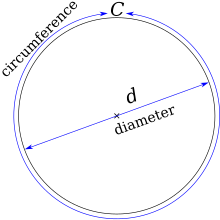
The circumference of a circle is slightly more than three times as long as its diameter. The exact ratio is called
π.
is commonly defined as the
ratio of a
circle's
circumference C to its
diameter d:
[1]

The ratio
C/d is constant, regardless of the circle's size. For example, if a circle has twice the diameter of another circle it will also have twice the circumference, preserving the ratio
C/d. This definition of
π is not universal, because it is valid only in
flat (Euclidean) geometry; it is not valid in
curved (non-Euclidean) geometries.
[1] For this reason, some mathematicians prefer definitions of
π based on
calculus or
trigonometry that do not rely on the circle. One such definition is:
π is twice the smallest positive
x for which
cos(x) equals 0.
[1][2]
Name

Leonhard Euler popularized the use of the Greek letter
π in a work he published in 1748.
The symbol used by mathematicians to represent the ratio of a circle's circumference to its diameter is the
Greek letter π. That letter (and therefore the number
π itself) can be denoted by the Latin word
pi.
[3] In English,
π is
pronounced as "pie" (
/paɪ/,
/ˈpaɪ/).
[4] The lower-case letter
π (or π in
sans-serif font) is not to be confused with the capital letter
Π, which denotes a
product of a sequence.
The first mathematician to use the Greek letter
π to represent the ratio of a circle's circumference to its diameter was
William Jones, who used it in his work
Synopsis Palmariorum Matheseos; or, a New Introduction to the Mathematics, of 1706.
[5] Jones' first use of the Greek letter was in the phrase "1/2 Periphery (
π)" in the discussion of a circle with radius one. He may have chosen
π because it was the first letter in the Greek spelling of the word
periphery.
[6] Jones writes that his equations for
π are from the "ready pen of the truly ingenious Mr. John Machin", leading to speculation that
Machin may have employed the Greek letter before Jones.
[7] The Greek letter had been used earlier for geometric concepts. For example, in 1631 it was used by
William Oughtred to represent the half-circumference of a circle.
[7]
After Jones introduced the Greek letter in 1706, it was not adopted by other mathematicians until
Euler used it in 1736. Before then, mathematicians sometimes used letters such as
c or
p instead.
[7] Because Euler corresponded heavily with other mathematicians in Europe, the use of the Greek letter spread rapidly.
[7] In 1748, Euler used
π in his widely read work
Introductio in analysin infinitorum (he wrote: "for the sake of brevity we will write this number as
π; thus
π is equal to half the circumference of a circle of radius 1") and the practice was universally adopted thereafter in the
Western world.
[7]
Properties
π is an
irrational number, meaning that it cannot be written as the
ratio of two integers, such as 22/7 or other fractions that are commonly used to approximate
π.
[8] Since
π is irrational, it has an infinite number of digits in its
decimal representation, and it does not end with an infinitely
repeating pattern of digits. There are several
proofs that π is irrational; they generally require calculus and rely on the
reductio ad absurdum technique. The degree to which
π can be approximated by
rational numbers (called the
irrationality measure) is not precisely known; estimates have established that the irrationality measure is larger than the measure of
e or ln(2), but smaller than the measure of
Liouville numbers.
[9]
π is a
transcendental number, which means that it is not the
solution of any non-constant
polynomial with
rational coefficients, such as
 [10][11]
[10][11] The transcendence of
π has two important consequences: First,
π cannot be expressed using any combination of rational numbers and square roots or
n-th roots such as
![\scriptstyle \sqrt[3]{31}](http://upload.wikimedia.org/math/6/4/8/64878d4d6f23518ce71af9b2c2bb2bbc.png)
or
![\scriptstyle \sqrt[2]{10}.](http://upload.wikimedia.org/math/9/6/4/9649bedec46bf796d0b832ee8f6fdcf0.png)
Second, since no transcendental number can be
constructed with
compass and straightedge, it is not possible to "
square the circle". In other words, it is impossible to construct, using compass and straightedge alone, a square whose area is equal to the area of a given circle.
[12] Squaring a circle was one of the important geometry problems of the
classical antiquity.
[13] Amateur mathematicians in modern times have sometimes attempted to square the circle, and sometimes claim success, despite the fact that it is impossible.
[14]
The digits of
π have no apparent pattern and pass tests for
statistical randomness including tests for
normality; a number of infinite length is called normal when all possible sequences of digits (of any given length) appear equally often.
[15] The hypothesis that
π is normal has not been proven or disproven.
[15] Since the advent of computers, a large number of digits of
π have been available on which to perform statistical analysis.
Yasumasa Kanada has performed detailed statistical analyses on the decimal digits of
π, and found them consistent with normality; for example, the frequency of the ten digits 0 to 9 were subjected to
statistical significance tests, and no evidence of a pattern was found.
[16] Despite the fact that
π's digits pass statistical tests for randomness,
π contains some sequences of digits that may appear non-random to non-mathematicians, such as the
Feynman point, which is a sequence of six consecutive 9s that begins at the 762nd decimal place of the decimal representation of
π.
[17]
Continued fractions
Like all irrational numbers,
π cannot be represented as a simple fraction. But every irrational number, including
π, can be represented by an infinite series of nested fractions, called a
continued fraction:

 A001203
A001203
Truncating the continued fraction at any point generates a fraction that provides an approximation for
π; two such fractions (22/7 and 355/113) have been used historically to approximate the constant. Each approximation generated in this way is a best rational approximation; that is, each is closer to
π than any other fraction with the same or a smaller denominator.
[18] Although the simple continued fraction for
π (shown above) does not exhibit a pattern,
[19] mathematicians have discovered several
generalized continued fractions that do, such as:
[20]

Approximate value
Some approximations of
π include:
- Fractions: Approximate fractions include (in order of increasing accuracy) 227, 333106, 355113, 5216316604, and 10399333102.[18]
- Decimal: The first 100 decimal digits are 3.14159 26535 89793 23846 26433 83279 50288 41971 69399 37510 58209 74944 59230 78164 06286 20899 86280 34825 34211 70679 ....[21]
 A000796
A000796
- Binary: 11.001001000011111101101010100010001000010110100011 ....
- Hexadecimal: The base 16 approximation to 20 digits is 3.243F6A8885A308D31319 ....[22]
- Sexagesimal: A base 60 approximation is 3:8:29:44:1
History
Antiquity
The
Great Pyramid at Giza, constructed c. 2589–2566 BC, was built with a perimeter of about 1760
cubits and a height of about 280 cubits; the ratio 1760/280 ≈ 6.2857 is approximately equal to 2
π ≈ 6.2832. Based on this ratio, some
Egyptologists concluded that the pyramid builders had knowledge of
π and deliberately designed the pyramid to incorporate the proportions of a circle.
[23] Others maintain that the suggested relationship to
π is merely a coincidence, because there is no evidence that the pyramid builders had any knowledge of
π, and because the dimensions of the pyramid are based on other factors.
[24]
The earliest written approximations of
π are found in Egypt and
Babylon, both within 1 percent of the true value. In Babylon, a
clay tablet dated 1900–1600 BC has a geometrical statement that, by implication, treats
π as 25/8 = 3.1250.
[25] In Egypt, the
Rhind Papyrus, dated around 1650 BC, but copied from a document dated to 1850 BC has a formula for the area of a circle that treats
π as (16/9)
2 ≈ 3.1605.
[25]
In India around 600 BC, the
Shulba Sutras (
Sanskrit texts that are rich in mathematical contents) treat
π as (9785/5568)
2 ≈ 3.088.
[26] In 150 BC, or perhaps earlier, Indian sources treat
π as

≈ 3.1622.
[27]
Two verses in the
Hebrew Bible (written between the 8th and 3rd centuries BC) describe a ceremonial pool in the
Temple of Solomon with a diameter of ten
cubits and a circumference of thirty cubits; the verses imply
π is about three if the pool is circular.
[28][29] Rabbi Nehemiah explained the discrepancy as being due to the thickness of the vessel. His early work of geometry,
Mishnat ha-Middot, was written around 150 AD and takes the value of
π to be three and one seventh.
[30]
Polygon approximation era

π can be estimated by computing the perimeters of circumscribed and inscribed polygons.
The first recorded algorithm for rigorously calculating the value of
π was a geometrical approach using polygons, devised around 250 BC by the Greek mathematician
Archimedes.
[31] This polygonal algorithm dominated for over 1,000 years, and as a result
π is sometimes referred to as "Archimedes' constant".
[32] Archimedes computed upper and lower bounds of
π by drawing a regular hexagon inside and outside a circle, and successively doubling the number of sides until he reached a 96-sided regular polygon. By calculating the perimeters of these polygons, he proved that 223/71 <
π < 22/7 (3.1408 <
π < 3.1429).
[33] Archimedes' upper bound of 22/7 may have led to a widespread popular belief that
π is equal to 22/7.
[34] Around 150 AD, Greek-Roman scientist
Ptolemy, in his
Almagest, gave a value for
π of 3.1416, which he may have obtained from Archimedes or from
Apollonius of Perga.
[35] Mathematicians using polygonal algorithms reached 39 digits of
π in 1630, a record only broken in 1699 when infinite series were used to reach 71 digits.
[36]

Archimedes developed the polygonal approach to approximating
π.
In ancient China, values for
π included 3.1547 (around 1 AD),

(100 AD, approximately 3.1623), and 142/45 (3rd century, approximately 3.1556).
[37] Around 265 AD, the
Wei Kingdom mathematician
Liu Hui created a
polygon-based iterative algorithm and used it with a 3,072-sided polygon to obtain a value of
π of 3.1416.
[38][39] Liu later invented a faster method of calculating
π and obtained a value of 3.14 with a 96-sided polygon, by taking advantage of the fact that the differences in area of successive polygons form a geometric series with a factor of 4.
[38] The Chinese mathematician
Zu Chongzhi, around 480 AD, calculated that
π ≈ 355/113 (a fraction that goes by the name
Milü in Chinese), using
Liu Hui's algorithm applied to a 12,288-sided polygon. With a correct value for its seven first decimal digits, this value of 3.141592920... remained the most accurate approximation of
π available for the next 800 years.
[40]
The Indian astronomer
Aryabhata used a value of 3.1416 in his
Āryabhaṭīya (499 AD).
[41] Fibonacci in c. 1220 computed 3.1418 using a polygonal method, independent of Archimedes.
[42] Italian author
Dante apparently employed the value

≈ 3.14142.
[42]
The Persian astronomer
Jamshīd al-Kāshī produced 16 digits in 1424 using a polygon with 3×2
28 sides,
[43][44] which stood as the world record for about 180 years.
[45] French mathematician
François Viète in 1579 achieved 9 digits with a polygon of 3×2
17 sides.
[45] Flemish mathematician
Adriaan van Roomen arrived at 15 decimal places in 1593.
[45] In 1596, Dutch mathematician
Ludolph van Ceulen reached 20 digits, a record he later increased to 35 digits (as a result,
π was called the "Ludolphian number" in Germany until the early 20th century).
[46] Dutch scientist
Willebrord Snellius reached 34 digits in 1621,
[47] and Austrian astronomer
Christoph Grienberger arrived at 38 digits in 1630,
[48] which remains the most accurate approximation manually achieved using polygonal algorithms.
[47]
Infinite series
The calculation of
π was revolutionized by the development of
infinite series techniques in the 16th and 17th centuries. An infinite series is the sum of the terms of an infinite
sequence.
[49] Infinite series allowed mathematicians to compute
π with much greater precision than
Archimedes and others who used geometrical techniques.
[49] Although infinite series were exploited for
π most notably by European mathematicians such as
James Gregory and
Gottfried Wilhelm Leibniz, the approach was first discovered in
India sometime between 1400 and 1500 AD.
[50] The first written description of an infinite series that could be used to compute
π was laid out in Sanskrit verse by Indian astronomer
Nilakantha Somayaji in his
Tantrasamgraha, around 1500 AD.
[51] The series are presented without proof, but proofs are presented in a later Indian work,
Yuktibhāṣā, from around 1530 AD. Nilakantha attributes the series to an earlier Indian mathematician,
Madhava of Sangamagrama, who lived c. 1350 – c. 1425.
[51] Several infinite series are described, including series for sine, tangent, and cosine, which are now referred to as the
Madhava series or
Gregory–Leibniz series.
[51] Madhava used infinite series to estimate
π to 11 digits around 1400, but that record was beaten around 1430 by the Persian mathematician
Jamshīd al-Kāshī, using a polygonal algorithm.
[52]

Isaac Newton used
infinite series to compute
π to 15 digits, later writing "I am ashamed to tell you to how many figures I carried these computations".
[53] The first infinite sequence discovered in Europe was an
infinite product (rather than an
infinite sum, which are more typically used in
π calculations) found by French mathematician
François Viète in 1593:
[54]

 A060294
A060294
The second infinite sequence found in Europe, by
John Wallis in 1655, was also an infinite product.
[54] The discovery of
calculus, by English scientist
Isaac Newton and German mathematician
Gottfried Wilhelm Leibniz in the 1660s, led to the development of many infinite series for approximating
π. Newton himself used an arcsin series to compute a 15 digit approximation of
π in 1665 or 1666, later writing "I am ashamed to tell you to how many figures I carried these computations, having no other business at the time."
[53]
In Europe, Madhava's formula was rediscovered by Scottish mathematician
James Gregory in 1671, and by Leibniz in 1674:
[55][56]

This formula, the Gregory–Leibniz series, equals

when evaluated with
z = 1.
[56] In 1699, English mathematician
Abraham Sharp used the Gregory–Leibniz series to compute
π to 71 digits, breaking the previous record of 39 digits, which was set with a polygonal algorithm.
[57] The Gregory–Leibniz series is simple, but
converges very slowly (that is, approaches the answer gradually), so it is not used in modern
π calculations.
[58]
In 1706
John Machin used the Gregory–Leibniz series to produce an algorithm that converged much faster:
[59]

Machin reached 100 digits of
π with this formula.
[60] Other mathematicians created variants, now known as
Machin-like formulae, that were used to set several successive records for
π digits.
[60] Machin-like formulae remained the best-known method for calculating
π well into the age of computers, and were used to set records for 250 years, culminating in a 620-digit approximation in 1946 by Daniel Ferguson – the best approximation achieved without the aid of a calculating device.
[61]
A remarkable record was set by the calculating prodigy
Zacharias Dase, who in 1844 employed a Machin-like formula to calculate 200 decimals of
π in his head at the behest of German mathematician
Carl Friedrich Gauss.
[62] British mathematician
William Shanks famously took 15 years to calculate
π to 707 digits, but made a mistake in the 528th digit, rendering all subsequent digits incorrect.
[62]
Rate of convergence
Some infinite series for
π converge faster than others. Given the choice of several infinite series for
π, mathematicians will generally use the one that converges most rapidly because faster convergence reduces the amount of computation needed to calculate
π to any given accuracy.
[63] A simple infinite series for
π is the
Gregory–Leibniz series:
[64]

As individual terms of this infinite series are added to the sum, the total gradually gets closer to
π, and – with a sufficient number of terms – can get as close to
π as desired. It converges quite slowly, though – after 500,000 terms, it produces only five correct decimal digits of
π.
[65]
An infinite series for
π (published by
Nilakantha Somayaji in the 15th century) that converges more rapidly than the Gregory–Leibniz series is:
[66]

Another that converges even more rapidly is the
arcsine series:

The following table compares the convergence rates of these three series:
| Infinite series for π | After 1 term | After 2 terms | After 3 terms | After 4 terms | After 5 terms | Converges to: |
 | 4.00000 | 2.66666... | 3.46666... | 2.89523... | 3.33968... | π = 3.14159... |
 | 3.00000 | 3.16666... | 3.13333... | 3.14523... | 3.13968... |
 | 3.00000 | 3.12500... | 3.13906... | 3.14115... | 3.14151... |
After five terms, the sum of the Gregory–Leibniz series is within 0.2 of the correct value of
π, whereas the sum of Nilakantha's series is within 0.002 of the correct value of
π, and the arcsine formula is within 0.0001 of the correct value of
π. Nilakantha's series converges faster, but the arcsine series is the fastest and most useful of the three for computing digits of
π. Series that converge even faster include
Machin's series and
Chudnovsky's series, the latter producing 14 correct decimal digits per term.
[63]
Irrationality and transcendence
Not all mathematical advances relating to
π were aimed at increasing the accuracy of approximations. When Euler solved the
Basel problem in 1735, finding the exact value of the sum of the reciprocal squares, he established a connection between
π and the
prime numbers that later contributed to the development and study of the
Riemann zeta function:
[67]

Swiss scientist
Johann Heinrich Lambert in 1761 proved that
π is
irrational, meaning it is not equal to the quotient of any two whole numbers.
[8] Lambert's proof exploited a continued-fraction representation of the tangent function.
[68] French mathematician
Adrien-Marie Legendre proved in 1794 that
π2 is also irrational. In 1882, German mathematician
Ferdinand von Lindemann proved that
π is
transcendental, confirming a conjecture made by both
Legendre and Euler.
[69]
Computer era and iterative algorithms
The development of computers in the mid-20th century again revolutionized the hunt for digits of
π. American mathematicians
John Wrench and Levi Smith reached 1,120 digits in 1949 using a desk calculator.
[70] Using an arctan infinite series, a team led by George Reitwiesner and
John von Neumann achieved 2,037 digits with a calculation that took 70 hours of computer time on the
ENIAC computer.
[71] The record, always relying on arctan series, was broken repeatedly (7,480 digits in 1957; 10,000 digits in 1958; 100,000 digits in 1961) until 1 million digits was reached in 1973.
[72]
Two additional developments around 1980 once again accelerated the ability to compute
π. First, the discovery of new
iterative algorithms for computing
π, which were much faster than the infinite series; and second, the invention of
fast multiplication algorithms that could multiply large numbers very rapidly.
[73] Such algorithms are particularly important in modern
π computations, because most of the computer's time is devoted to multiplication.
[74] They include the
Karatsuba algorithm,
Toom–Cook multiplication, and
Fourier transform-based methods.
[75]
The iterative algorithms were independently published in 1975–1976 by American physicist
Eugene Salamin and Australian scientist
Richard Brent.
[76] These avoid reliance on infinite series. An iterative algorithm repeats a specific calculation, each iteration using the outputs from prior steps as its inputs, and produces a result in each step that converges to the desired value. The approach was actually invented over 160 years earlier by
Carl Friedrich Gauss, in what is now termed the
arithmetic–geometric mean method (AGM method) or
Gauss–Legendre algorithm.
[76] As modified by Salamin and Brent, it is also referred to as the Brent–Salamin algorithm.
The iterative algorithms were widely used after 1980 because they are faster than infinite series algorithms: whereas infinite series typically increase the number of correct digits additively in successive terms, iterative algorithms generally
multiply the number of correct digits at each step. For example, the Brent-Salamin algorithm doubles the number of digits in each iteration. In 1984, the Canadian brothers
John and
Peter Borwein produced an iterative algorithm that quadruples the number of digits in each step; and in 1987, one that increases the number of digits five times in each step.
[77] Iterative methods were used by Japanese mathematician
Yasumasa Kanada to set several records for computing
π between 1995 and 2002.
[78] This rapid convergence comes at a price: the iterative algorithms require significantly more memory than infinite series.
[78]
Motivations for computing π

As mathematicians discovered new algorithms, and computers became available, the number of known decimal digits of
π increased dramatically.
For most numerical calculations involving
π, a handful of digits provide sufficient precision. According to Jörg Arndt and Christoph Haenel, thirty-nine digits are sufficient to perform most
cosmological calculations, because that is the accuracy necessary to calculate the volume of the known universe with a precision of one atom.
[79] Despite this, people have worked strenuously to compute
π to thousands and millions of digits.
[80] This effort may be partly ascribed to the human compulsion to break records, and such achievements with
π often make headlines around the world.
[81][82] They also have practical benefits, such as testing
supercomputers, testing numerical analysis algorithms (including
high-precision multiplication algorithms); and within pure mathematics itself, providing data for evaluating the randomness of the digits of
π.
[83]
Rapidly convergent series
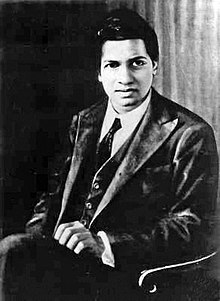
Srinivasa Ramanujan, working in isolation in India, produced many innovative series for computing
π.
Modern
π calculators do not use iterative algorithms exclusively. New infinite series were discovered in the 1980s and 1990s that are as fast as iterative algorithms, yet are simpler and less memory intensive.
[78] The fast iterative algorithms were anticipated in 1914, when the Indian mathematician
Srinivasa Ramanujan published dozens of innovative new formulae for
π, remarkable for their elegance, mathematical depth, and rapid convergence.
[84] One of his formulae, based on
modular equations:

This series converges much more rapidly than most arctan series, including Machin's formula.
[85] Bill Gosper was the first to use it for advances in the calculation of
π, setting a record of 17 million digits in 1985.
[86] Ramanujan's formulae anticipated the modern algorithms developed by the Borwein brothers and the
Chudnovsky brothers.
[87] The
Chudnovsky formula developed in 1987 is

It produces about 14 digits of
π per term,
[88] and has been used for several record-setting
π calculations, including the first to surpass (10
9) digits in 1989 by the Chudnovsky brothers, 2.7 trillion (2.7×10
12) digits by
Fabrice Bellard in 2009, and 10 trillion (10
13) digits in 2011 by Alexander Yee and Shigeru Kondo.
[89][90]
In 2006, Canadian mathematician
Simon Plouffe used the PSLQ
integer relation algorithm[91] to generate several new formulae for
π, conforming to the following template:

where

is
eπ (Gelfond's constant),

is an
odd number, and

are certain rational numbers that Plouffe computed.
[92]
Spigot algorithms
Two algorithms were discovered in 1995 that opened up new avenues of research into
π. They are called
spigot algorithms because, like water dripping from a spigot, they produce single digits of
π that are not reused after they are calculated.
[93][94] This is in contrast to infinite series or iterative algorithms, which retain and use all intermediate digits until the final result is produced.
[93]
American mathematicians
Stan Wagon and Stanley Rabinowitz produced a simple spigot algorithm in 1995.
[94][95][96] Its speed is comparable to arctan algorithms, but not as fast as iterative algorithms.
[95]
Another spigot algorithm, the
BBP digit extraction algorithm, was discovered in 1995 by Simon Plouffe:
[97][98]

This formula, unlike others before it, can produce any individual
hexadecimal digit of
π without calculating all the preceding digits.
[97] Individual
octal or binary digits may be extracted from the hexadecimal digits. Variations of the algorithm have been discovered, but no digit extraction algorithm has yet been found that rapidly produces decimal digits.
[99] An important application of digit extraction algorithms is to validate new claims of record
π computations: After a new record is claimed, the decimal result is converted to hexadecimal, and then a digit extraction algorithm is used to calculate several random hexadecimal digits near the end; if they match, this provides a measure of confidence that the entire computation is correct.
[90]
Between 1998 and 2000, the
distributed computing project
PiHex used
Bellard's formula (a modification of the BBP algorithm) to compute the quadrillionth (10
15th) bit of
π, which turned out to be 0.
[100] In September 2010, a
Yahoo! employee used the company's
Hadoop application on one thousand computers over a 23-day period to compute 256
bits of
π at the two-quadrillionth (2×10
15th) bit.
[101]
Use
Because
π is closely related to the circle, it is found in many formulae from the fields of geometry and trigonometry, particularly those concerning circles, spheres, or ellipses. Formulae from other branches of science also include
π in some of their important formulae, including sciences such as statistics, fractals, thermodynamics, mechanics, cosmology, number theory, and electromagnetism.
Geometry and trigonometry

The area of the circle equals
π times the shaded area.
appears in formulae for areas and volumes of geometrical shapes based on circles, such as
ellipses,
spheres,
cones, and
tori. Some of the more common formulae that involve
π:
[102]
- The circumference of a circle with radius r is

- The area of a circle with radius r is

- The volume of a sphere with radius r is

- The surface area of a sphere with radius r is

π appears in
definite integrals that describe circumference, area, or volume of shapes generated by circles. For example, an integral that specifies half the area of a circle of radius one is given by:
[103]

In that integral the function

represents the top half of a circle (the
square root is a consequence of the
Pythagorean theorem), and the integral

computes the area between that half a circle and the
x axis.
The
trigonometric functions rely on angles, and mathematicians generally use radians as units of measurement.
π plays an important role in angles measured in
radians, which are defined so that a complete circle spans an angle of 2
π radians.
[104] The angle measure of 180° is equal to
π radians, and 1° =
π/180 radians.
[104]
Common trigonometric functions have periods that are multiples of
π; for example, sine and cosine have period 2
π,
[105] so for any angle
θ and any integer
k,

and
 [105]
[105]
Monte Carlo methods
Random dots are placed on a square with a circle inscribed in it.
, which evaluate the results of multiple random trials, can be used to create approximations of
π.
[106] Buffon's needle is one such technique: If a needle of length
ℓ is dropped
n times on a surface on which parallel lines are drawn
t units apart, and if
x of those times it comes to rest crossing a line (
x > 0), then one may approximate
π based on the counts:
[107]

Another Monte Carlo method for computing
π is to draw a circle inscribed in a square, and randomly place dots in the square. The ratio of dots inside the circle to the total number of dots will approximately equal
 [108]
[108]
Monte Carlo methods for approximating
π are very slow compared to other methods, and are never used to approximate
π when speed or accuracy are desired.
[109]
Complex numbers and analysis
Any
complex number, say
z, can be expressed using a pair of
real numbers. In the
polar coordinate system, one number (radius or
r) is used to represent
z's distance from the
origin of the
complex plane and the other (angle or
φ) to represent a counter-clockwise
rotation from the positive real line as follows:
[110]

where
i is the
imaginary unit satisfying
i2 = −1. The frequent appearance of
π in
complex analysis can be related to the behavior of the
exponential function of a complex variable, described by
Euler's formula:
[111]

where
the constant e is the base of the
natural logarithm. This formula establishes a correspondence between imaginary powers of
e and points on the
unit circle centered at the origin of the complex plane. Setting
φ =
π in Euler's formula results in
Euler's identity, celebrated by mathematicians because it contains the five most important mathematical constants:
[111][112]

There are
n different
complex numbers z satisfying

, and these are called the "
n-th
roots of unity".
[113] They are given by this formula:

Cauchy's integral formula governs
complex analytic functions and establishes an important relationship between integration and differentiation, including the remarkable fact that the values of a complex function within a closed boundary are entirely determined by the values on the boundary:
[114][115]


π can be computed from the
Mandelbrot set, by counting the number of iterations required before point (−0.75, ε) diverges.
An occurrence of
π in the
Mandelbrot set fractal was discovered by American David Boll in 1991.
[116] He examined the behavior of the Mandelbrot set near the "neck" at (−0.75, 0). If points with coordinates (−0.75, ε) are considered, as ε tends to zero, the number of iterations until divergence for the point multiplied by ε converges to
π. The point (0.25, ε) at the cusp of the large "valley" on the right side of the Mandelbrot set behaves similarly: the number of iterations until divergence multiplied by the square root of ε tends to
π.
[116][117]
The
gamma function extends the concept of
factorial – which is normally defined only for whole numbers – to all real numbers. When the gamma function is evaluated at half-integers, the result contains
π; for example

and

.
[118] The gamma function can be used to create a simple approximation to

for large

:

which is known as
Stirling's approximation.
[119]
Number theory and Riemann zeta function
The
Riemann zeta function ζ(
s) is used in many areas of mathematics. When evaluated at

it can be written as

Finding a
simple solution for this infinite series was a famous problem in mathematics called the
Basel problem.
Leonhard Euler solved it in 1735 when he showed it was equal to

.
[67] Euler's result leads to the
number theory result that the probability of two random numbers being
relatively prime (that is, having no shared factors) is equal to

.
[120][121] This probability is based on the observation that the probability that any number is
divisible by a prime

is

(for example, every 7th integer is divisible by 7.) Hence the probability that two numbers are both divisible by this prime is

, and the probability that at least one of them is not is

. For distinct primes, these divisibility events are mutually independent; so the probability that two numbers are relatively prime is given by a product over all primes:
[122]

This probability can be used in conjunction with a
random number generator to approximate
π using a Monte Carlo approach.
[123]
Physics
Although not a
physical constant,
π appears routinely in equations describing fundamental principles of the universe, often because of
π's relationship to the circle and to
spherical coordinate systems. A simple formula from the field of
classical mechanics gives the approximate period
T of a simple
pendulum of length
L, swinging with a small amplitude (
g is the
earth's gravitational acceleration):
[124]

One of the key formulae of
quantum mechanics is
Heisenberg's uncertainty principle, which shows that the uncertainty in the measurement of a particle's position (Δ
x) and
momentum (Δ
p) cannot both be arbitrarily small at the same time (where
h is
Planck's constant):
[125]

In the domain of
cosmology,
π appears in one of the fundamental formulae:
Einstein's field equation, which forms the basis of the
general theory of relativity and describes the
fundamental interaction of
gravitation as a result of
spacetime being
curved by
matter and
energy:
[126]

where

is the
Ricci curvature tensor,

is the
scalar curvature,

is the
metric tensor,

is the
cosmological constant,

is
Newton's gravitational constant,

is the
speed of light in vacuum, and

is the
stress–energy tensor.
Coulomb's law, from the discipline of
electromagnetism, describes the
electric field between two
electric charges (
q1 and
q2) separated by distance
r (with
ε0 representing the
vacuum permittivity of free space):
[127]

The fact that
π is approximately equal to 3 plays a role in the relatively long lifetime of
orthopositronium. The inverse lifetime to lowest order in the fine structure constant

is given by
[128]:

where m is the mass of the electron.
Probability and statistics

A graph of the
Gaussian function
ƒ(
x) =
e−x2. The colored region between the function and the
x-axis has area

.
The fields of
probability and
statistics frequently use the
normal distribution as a simple model for complex phenomena; for example, scientists generally assume that the observational error in most experiments follows a normal distribution.
[129] π is found in the
Gaussian function (which is the
probability density function of the normal distribution) with
mean μ and
standard deviation σ:
[130]
-

The area under the graph of the normal distribution curve is given by the
Gaussian integral:
[130]
 ,
,
while the related integral for the
Cauchy distribution is
 .
.
Engineering and geology
π is present in some structural engineering formulae, such as the
buckling formula derived by Euler, which gives the maximum axial load
F that a long, slender column of length
L,
modulus of elasticity E, and
area moment of inertia I can carry without buckling:
[131]

The field of
fluid dynamics contains
π in
Stokes' law, which approximates the
frictional force F exerted on small,
spherical objects of radius
R, moving with velocity
v in a
fluid with
dynamic viscosity η:
[132]

The
Fourier transform is a mathematical operation that expresses time as a
function of
frequency, known as its
frequency spectrum. It has many applications in
physics and
engineering, particularly in
signal processing:
[133]

Under ideal conditions (uniform gentle slope on an homogeneously erodible substrate), the
sinuosity of a
meandering river approaches
π. The sinuosity is the ratio between the actual length and the straight-line distance from source to mouth. Faster currents along the outside edges of a river's bends cause more erosion than along the inside edges, thus pushing the bends even farther out, and increasing the overall loopiness of the river. However, that loopiness eventually causes the river to double back on itself in places and "short-circuit", creating an
ox-bow lake in the process. The balance between these two opposing factors leads to an average ratio of
π between the actual length and the direct distance between source and mouth.
[134][135]
Outside the sciences
Memorizing digits
Main article:
PiphilologyMany persons have memorized large numbers of digits of
π, a practice called
piphilology.
[136] One common technique is to memorize a story or poem, in which the word-lengths represent the digits of
π: The first word has three letters, the second word has one, the third has four, the fourth has one, the fifth has five, and so on. An early example of a memorization aid, originally devised by English scientist
James Jeans, is: "How I want a drink, alcoholic of course, after the heavy lectures involving quantum mechanics."
[136] When a poem is used, it is sometimes referred to as a "piem". Poems for memorizing
π have been composed in several languages in addition to English.
[136]
The record for memorizing digits of
π, certified by
Guinness World Records, is 67,890 digits, recited in China by
Lu Chao in 24 hours and 4 minutes on 20 November 2005.
[137][138] In 2006,
Akira Haraguchi, a retired Japanese engineer, claimed to have recited 100,000 decimal places, but the claim was not verified by Guinness World Records.
[139] Record-setting
π memorizers typically do not rely on poems, but instead use methods such as remembering number patterns and the
method of loci.
[140]
A few authors have used the digits of
π to establish a new form of
constrained writing, where the word-lengths are required to represent the digits of
π. The
Cadaeic Cadenza contains the first 3835 digits of
π in this manner,
[141] and the full-length book
Not a Wake contains 10,000 words, each representing one digit of
π.
[142]
In popular culture

A pi pie. The circular shape of
pie makes it a frequent subject of pi
puns.
Perhaps because of the simplicity of its definition and its ubiquitous presence in formulae,
π has been represented in popular culture more than other mathematical constructs. In the
Palais de la Découverte (a science museum in Paris) there is a circular room known as the "pi room". On its wall are inscribed 707 digits of
π. The digits are large wooden characters attached to the dome-like ceiling. The digits were based on an 1853 calculation by English mathematician
William Shanks, which included an error beginning at the 528th digit. The error was detected in 1946 and corrected in 1949.
[143]
e to the u, du / dx e to the x, dx Cosine, secant, tangent, sine 3.14159 Integral, radical, mu dv Slipstick, slide rule, MIT! GOOOOOO TECH!
Many schools in the United States observe
Pi Day on 14 March (March is the third month, hence the date is 3/14).
[145] π and its digital representation are often used by self-described "math
geeks" for
inside jokes among mathematically and technologically minded groups. Several college
cheers at the
Massachusetts Institute of Technology include "3.14159".
[144] During the 2011 auction for
Nortel's portfolio of valuable technology patents,
Google made a series of unusually specific bids based on mathematical and scientific constants, including
π.
[146]
Proponents of a new mathematical constant tau (
τ), equal to two times
π, have argued that a constant based on the ratio of a circle's circumference to its radius rather than to its diameter would be more natural and would simplify many formulae.
[147][148] While their proposals, which include celebrating 28 June as "Tau Day", have been reported in the media, they have not been reflected in the scientific literature.
[149][150]
In
Carl Sagan's novel
Contact it is suggested that the creator of the universe buried a message deep within the digits of
π.
[151] The digits of
π have also been incorporated into the lyrics of the song "Pi" from the album
Aerial by
Kate Bush,
[152] and a song by
Hard 'n Phirm.
[153]
In 1897, an amateur mathematician attempted to persuade the
Indiana legislature to pass the
Indiana Pi Bill, which described a method to
square the circle, and contained text which assumes various incorrect values of
π, including 3.2. The bill is notorious as an attempt to establish scientific truth by legislative fiat. The bill was passed by the Indiana House of Representatives, but rejected by the Senate.
[154]
In the
Doctor Who episode "
Midnight", the Doctor encounters the Midnight Entity that takes over the body of various characters. The character Sky Silvestry when taken over mimics the speech patterns of The Doctor by repeating, in synchronism, the
square root of pi to 30 decimal places.
[155] This involved the actors
David Tennant and
Leslie Sharp learning the sequence to be able to repeat it.
Pi appears in crop circle
If we are to believe the latest signs from outer space, the local aliens are keen mathematicians.
A new crop circle appeared on the 1st of June this year in a barley field near Barbury Castle in Wiltshire, England, measuring 150 feet in diameter and correctly representing the first 10 digits of the irrational constant pi.
If you look at figure 1, you will notice that the grooves in the circle spiral outwards with steps at various points along the way. Taking a look now at figure 2, you will see that these steps occur at particular angles — the circle is divided into 10 equal segments of 36 degrees each. Starting at the centre, you can see that the first section is 3 segments wide. Then there is a step and underneath this step is a small circle. This is the decimal point. The next section is 1 segment wide and then there is another step. The following section is 4 segments wide, and so on until the final number encoded is 3.141592654. Michael Reed, the astrophysicist who first decoded the image, is quoted on
earthfiles.com as saying:
"The fact that the Pi decimal point is included and there is rounding up to 10 decimal places is to me a little mind boggling!"
The location of the new Pi crop circle is 51.488258 degrees north, 1.771964 west, but unfortunately it has not yet appeared on
Google maps.
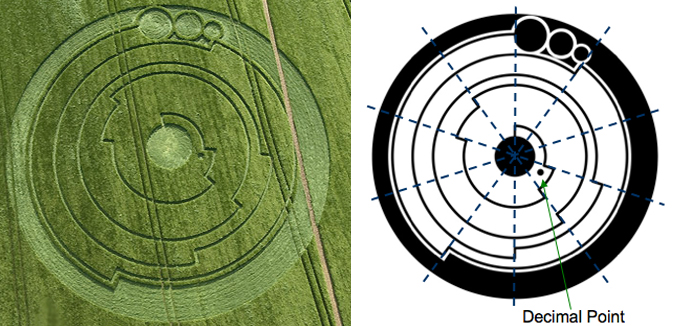
Figure 2: Right image shows the circle divided into 10 equal segments. The number of segments moved through at each step, starting from the centre, denotes a decimal point of Pi. Left image courtesy
The Crop Circle Connector.
This latest crop circle has appeared on the eve of the new X-files movie
I want to believe and has created quite a storm amongst crop circle enthusiasts. Lucy Pringle, a crop circle researcher, was quoted in
The Scotsman as finding it hard to believe such an intricate crop circle could have been created by humans, and whilst there was rain the night before it appeared, there was no mud inside the formation.
"You can do it on a computer, but you try putting that in a field in the middle of the night and achieving that degree of mathematical accuracy."
Pringle's theory is that crop circles are created by a spiralling electromagnetic force that hits the ground for a nanosecond.
Local councillor Stewart Dobson said: "It's hard to believe somebody managed to work (the design) out so it shows pi so accurately. It's either a very educated person who has done it or a very educated alien."
Plus tends to think that an alien capable of making it millions of light years across the Universe to visit us is more than likely to have some understanding of pi...
It is not the first time mathematics has appeared in a crop circle. Indeed, whether it's the nerdy nature of crop circle fraudsters, or because aliens choose maths as a method of communication because of its fundamental role in the Universe, mathematical patterns are fairly common. One of the best-known mathematical crop circles appeared in the form of the Julia set 12 years ago, again in Wiltshire, near Stone Henge.
For the latest buzz on this crop circle, and to have a peek at all the theories regarding it, see
crop circle connector. And whatever caused these mathematical imprints on the face of the Earth, always remember, the truth is out there.



 the radius of the circle, and
the radius of the circle, and  is the arc length of the minor sector.
is the arc length of the minor sector.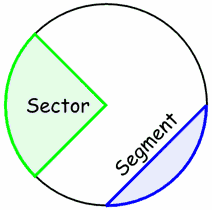
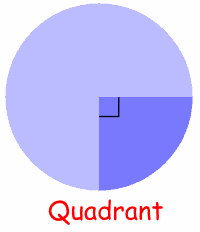

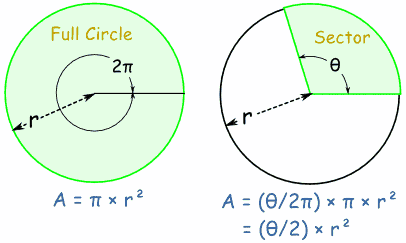
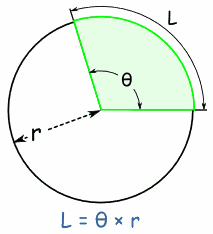
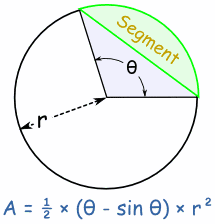
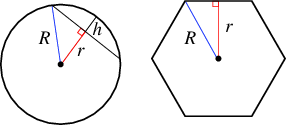 Given a
Given a 




![\scriptstyle \sqrt[3]{31}](http://upload.wikimedia.org/math/6/4/8/64878d4d6f23518ce71af9b2c2bb2bbc.png) or
or ![\scriptstyle \sqrt[2]{10}.](http://upload.wikimedia.org/math/9/6/4/9649bedec46bf796d0b832ee8f6fdcf0.png) Second, since no transcendental number can be
Second, since no transcendental number can be 


 ≈ 3.1622.
≈ 3.1622.

 ≈ 3.14142.
≈ 3.14142.


 when evaluated with
when evaluated with 

















 is
is  is an
is an  are certain rational numbers that Plouffe computed.
are certain rational numbers that Plouffe computed.






 represents the top half of a circle (the
represents the top half of a circle (the  computes the area between that half a circle and the
computes the area between that half a circle and the 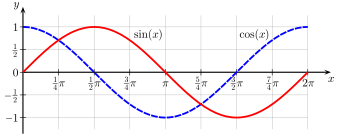
 and
and 








 , and these are called the "
, and these are called the "


 and
and  .
. for large
for large  :
:  which is known as
which is known as  it can be written as
it can be written as
 .
. .
. is
is  (for example, every 7th integer is divisible by 7.) Hence the probability that two numbers are both divisible by this prime is
(for example, every 7th integer is divisible by 7.) Hence the probability that two numbers are both divisible by this prime is  , and the probability that at least one of them is not is
, and the probability that at least one of them is not is  . For distinct primes, these divisibility events are mutually independent; so the probability that two numbers are relatively prime is given by a product over all primes:
. For distinct primes, these divisibility events are mutually independent; so the probability that two numbers are relatively prime is given by a product over all primes:



 is the
is the  is the
is the  is the
is the  is the
is the  is
is  is the
is the  is the
is the 
 is given by
is given by 

 .
.
 ,
, .
.



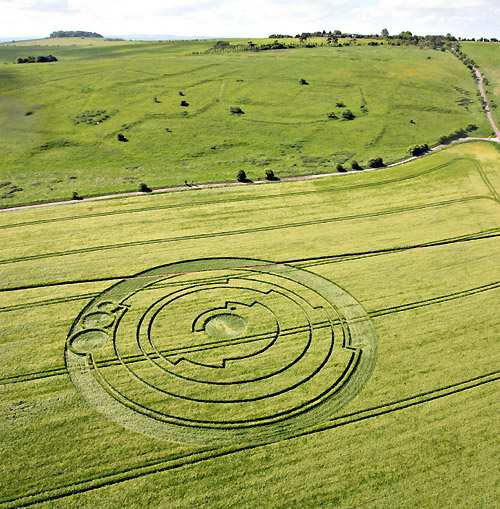 Figure 1: Barbury Castle crop circle denoting Pi. Crop Circle photos and reports courtesy
Figure 1: Barbury Castle crop circle denoting Pi. Crop Circle photos and reports courtesy  Figure 2: Right image shows the circle divided into 10 equal segments. The number of segments moved through at each step, starting from the centre, denotes a decimal point of Pi. Left image courtesy
Figure 2: Right image shows the circle divided into 10 equal segments. The number of segments moved through at each step, starting from the centre, denotes a decimal point of Pi. Left image courtesy 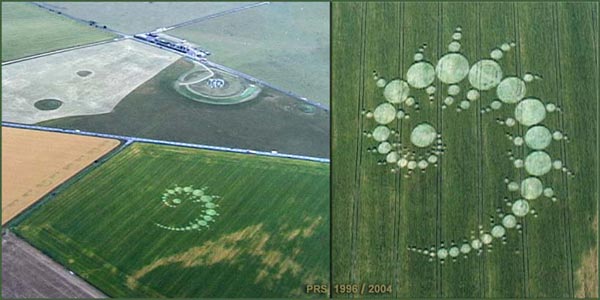 The Julia set crop circle. Image courtesy
The Julia set crop circle. Image courtesy